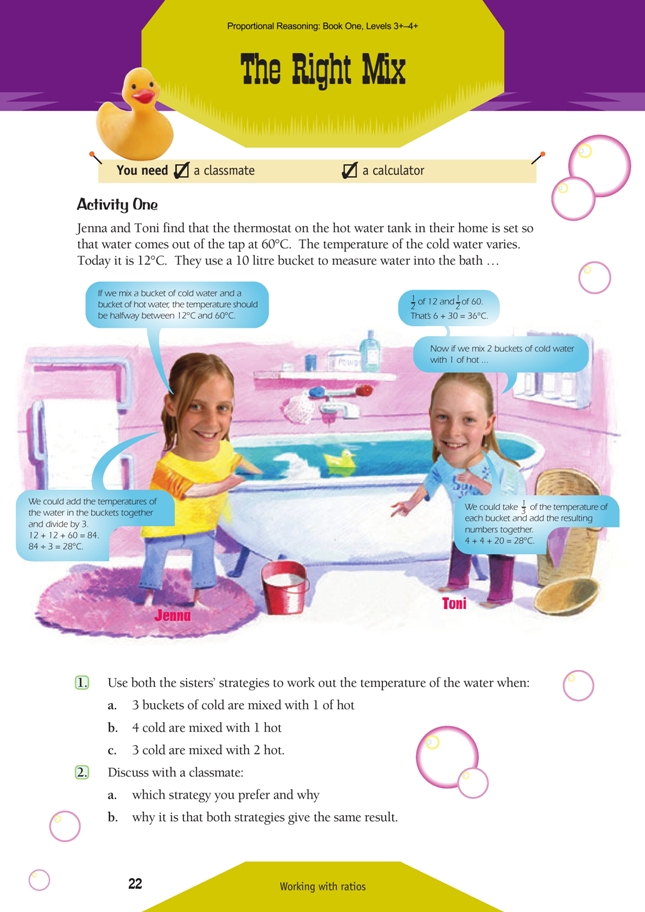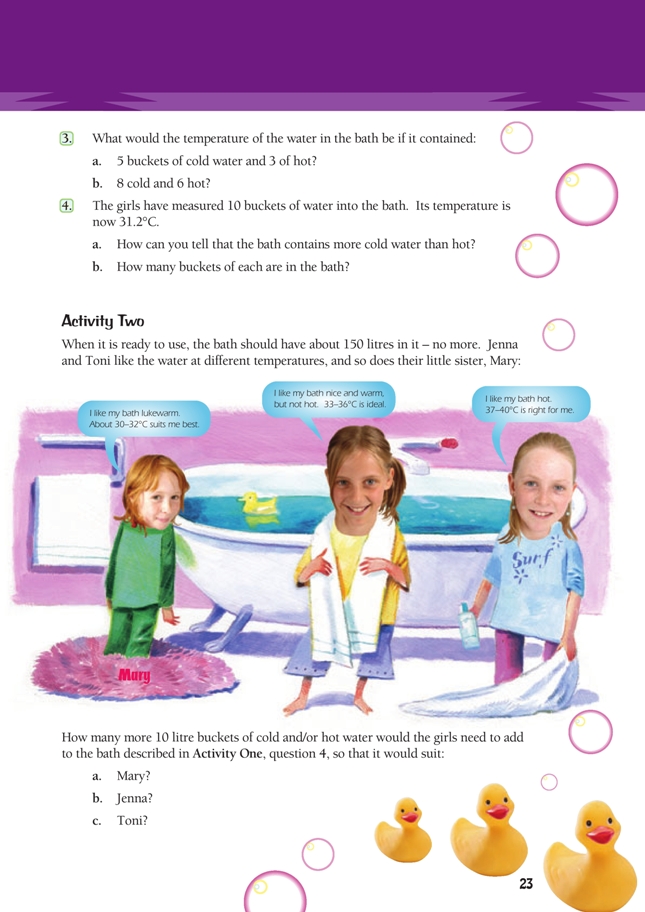This is a level 5 number activity from the Figure It Out series. It relates to Stage 8 of the Number Framework.
A PDF of the student activity is included.
Click on the image to enlarge it. Click again to close. Download PDF (694 KB)
solve problems involving ratios
Number Framework Links
Use this activity to:
• encourage the transition from advanced multiplicative strategies (stage 7) to advanced proportional strategies (stage 8)
• develop confidence in students who are beginning to use advanced proportional strategies (stage 8).
FIO, Level 3-4+, Proportional Reasoning, Book One, The Right Mix, pages 22-23
A calculator
Activity One
This context may be a little artificial (filling a bathtub using buckets of hot and cold water), but it provides a strong visual model of ratios at work.
Have your students read and discuss the illustrated scenario. Encourage them to link the data in the number story with the equations in the speech bubbles. Good focusing questions could be:
• What was the data that suggested to Jenna that she should divide by 3?
• How did Toni use the same piece of data in her strategy?
From this discussion, the students will see that the total number of buckets is critical information and that dividing by 3 has the same effect as multiplying by 1/3.
Use question 1 to get the students to examine the ratios of hot to cold and express these as proportions of the total volume. In question 1a, for example, 3 buckets of cold to 1 of hot is expressed as the ratio 3:1. This means that the cold is 3/4 of the total volume and the hot is 1/4 of the total volume. It is important that students understand both ways of viewing the data.
In question 2a, ensure that your students think about “the easiest way for me” as well as “the most efficient way” when considering which is their preferred strategy. Toni’s strategy is neither easy nor efficient unless the number of buckets is a whole number factor of both the cold and hot temperatures.
Question 2b is a key question as it seeks to have students see the big idea behind both strategies and express it as a generalisation.
Ask the students to record the full equation for Jenna’s strategy: (12 + 12 + 60) ÷ 3 = 28. Do the same for Toni: (1/3 x 12) + (1/3 x 12) + (1/3 x 60) = 28. Help the students rewrite this as 12/3 + 12/3 + 60/3 = 28.
By comparing the first and last of these three equations, we can make a new equation:
(12 + 12 + 60) ÷ 3 = 12/3 + 12/3 + 60/3. This equation shows that adding the parts and dividing by 3 gives the same result as dividing the parts by 3 and then adding. This is an illustration of the distributive principle at work: the factor 3 is distributed over each of the addends inside the brackets. Many mathematical calculations (including all part–whole strategies) and algebraic manipulations make
use of this very important principle.
Question 3 gives students further practice using the strategies they explored in question 2.
The first part of question 4 comes from a new angle, and to answer it, students should reread the conversation in the introduction and see if they can make use of the information there in a different way. The key is to notice that equal amounts of hot and cold water will give a temperature of 36°C.
The bath is below this temperature, so there must be more cold than hot. Equal cold and hot would mean 5c + 5h. 6c + 4h gives 31.2°C.
Activity Two
When discussing this activity, highlight the two instructions, “150 litres in it – no more,” and “How many more 10 litre buckets ...?” They are essential to the problem. Students will need to have the correct answer for Activity One, question 4b (6 buckets of cold water and 4 of hot) to work from.
The activity deliberately begins with Mary because the bath is already at a temperature that suits her and if that was all that was required, the girls would not need to add any more water. But the bath isn’t yet full enough, so the challenge is to bring it up to the desired level while keeping its temperature within the preferred range.
There are at least four approaches that students might follow. You may need to model how to record them:
1. Given that the existing cold:hot ratio is 6:4 or 3:2, 3/5 must be cold and 2/5 must be hot. 3/5 of 15 is 9, so Mary needs 9 buckets of cold water and 6 buckets of hot. This is 3 more buckets of cold water and 2 more of hot.
2. Mary needs to add 5 more buckets to bring the bath up to the desired level. Because the ratio of cold to hot is 3:2, 3 of these extra 5 buckets must be cold and 2 must be hot.
3. Trial and improvement. There are not many ways of splitting 5 into 2 using whole numbers only.
4. Chart all possibilities and their outcomes (temperatures) in a table and then see which suits each of the girls.
Starting with the bath described in Activity One, question 4, it should be clear that Toni will need a little more cold than hot and Jenna will need a little more hot than cold. This will reduce even further the number of possibilities that the students have to consider.
Answers to Activities
Activity One
1. a. Jenna: 12 + 12 + 12 + 60 = 96, 96 ÷ 4 = 24°C.
Toni: 3 + 3 + 3 + 15 = 24°C.
b. Jenna: 12 + 12 + 12 + 12 + 60 = 108, 108 ÷ 5 = 21.6°C.
Toni: 2 2/5 + 2 2/5 + 2 2/5 + 2 2/5 + 12 = 9 3/5 + 12 = 21.6°C.
c. Jenna: 12 + 12 + 12 + 60 + 60 = 156, 156 ÷ 5 = 31.2°C.
Toni: 2 2/5 + 2 2/5 + 2 2/5 + 12 + 12 = 7 1/5 + 24 = 31.2°C.
2. a. Discussion will vary. Where no fractions are involved (question 1a) Toni’s strategy is quick and easy. Where fractions are involved or a calculator is needed, Jenna’s strategy will be best.
b. If you add two or more numbers and take a fraction of the total, you get exactly the same result as first taking a fraction of each of those numbers and then adding them. This important mathematical idea is known as the distributive principle.
Example: (1 + 1) ÷ 4 = 2/4 = 1/2 is the same as 1/4 + 1/4 = 1/2
3. a. 30°C. (5 x 12 + 3 x 60) ÷ 8 = 30°C
b. 32.6°C. (8 x 12 + 6 x 60) ÷ 14 = 32.6°C
4. a. We know from the girls’ conversation that if there are equal quantities of cold and hot the temperature will be 36°C. Because the temperature is less than this, there must be more cold than hot.
b. 6 cold and 4 hot. (Trying possible combinations)
Activity Two
a. Add 3c and 2h. This will fill the bath to the 150 L mark and keep the temperature at 31.2°C.
b. Add 2c and 3h. This will fill the bath to the right level and make the temperature 34.4°C.
c. Add 1c and 4h. This will fill the bath to the right level and make the temperature 37.6°C.

